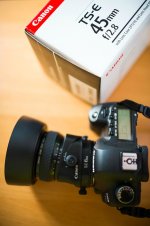As Raymond has said Genoma, getting your head around Tilt Shift (or Perspective Control) lenses does take a bit of getting used to.
Take a look at the following Youtube video from Adorama, it explains it quite well.
http://www.youtube.com/watch?v=9TTB6hKxKzE
In quite a few of the shots Marzipanogram has used the Shift ability of the lens to correct converging uprights. Shift the lens upwards, then move the camera down, this correct the verticals.
As Raymond has mentions, you can also keep the camera steady on a tripod, take one shot, then shift the lens to the far left, take another shot, then shift the lens to the far right and take a third shot. Each shot can then be stitched together to make a panoramic shot, using a program like Microsoft ICE.
The Tilt ability is what people normally associate with a Tilt Shift lens. It can give that miniature toy town look. However it can be much more useful than that. In Landscape Photography or Product Photography you can move the plane of focus to get everything from near to far in focus at the maximum aperture of the lens - no need to stop down the lens if you don't want to.
I suspect Raymond will use this more since you can move the area where you've focused around the image, e.g focus on a bride and groom in a shot and make everything around them out of focus, including things that are the same distance from the camera.
They really are beautifully made lenses, I took delivery of the Canon TS-E 24mm f/3.5L II a week or so ago, the quality and sharpness of shots is astounding when you get it right.
One thing you have to be mindful of is that when you shift or tilt the lens, the metering will be off, so you have to meter without tilt or shift, then dial the settings in manually (or use a Light meter when your lens is set up and dial that in).









